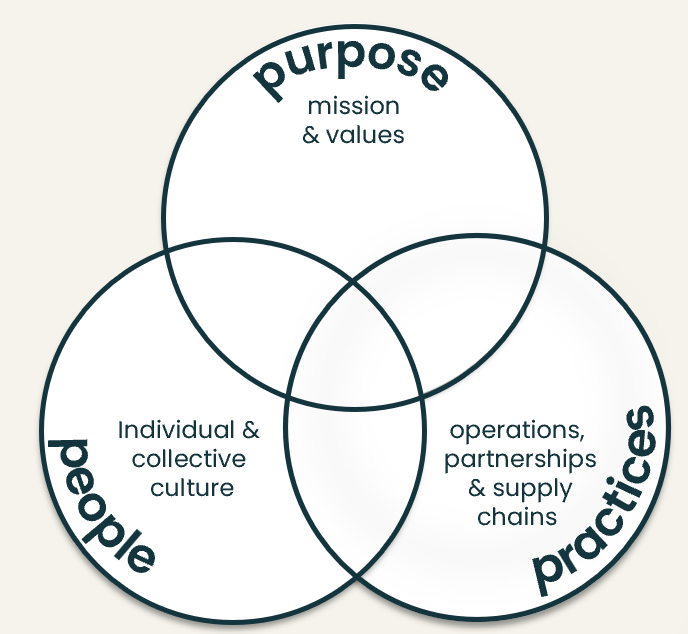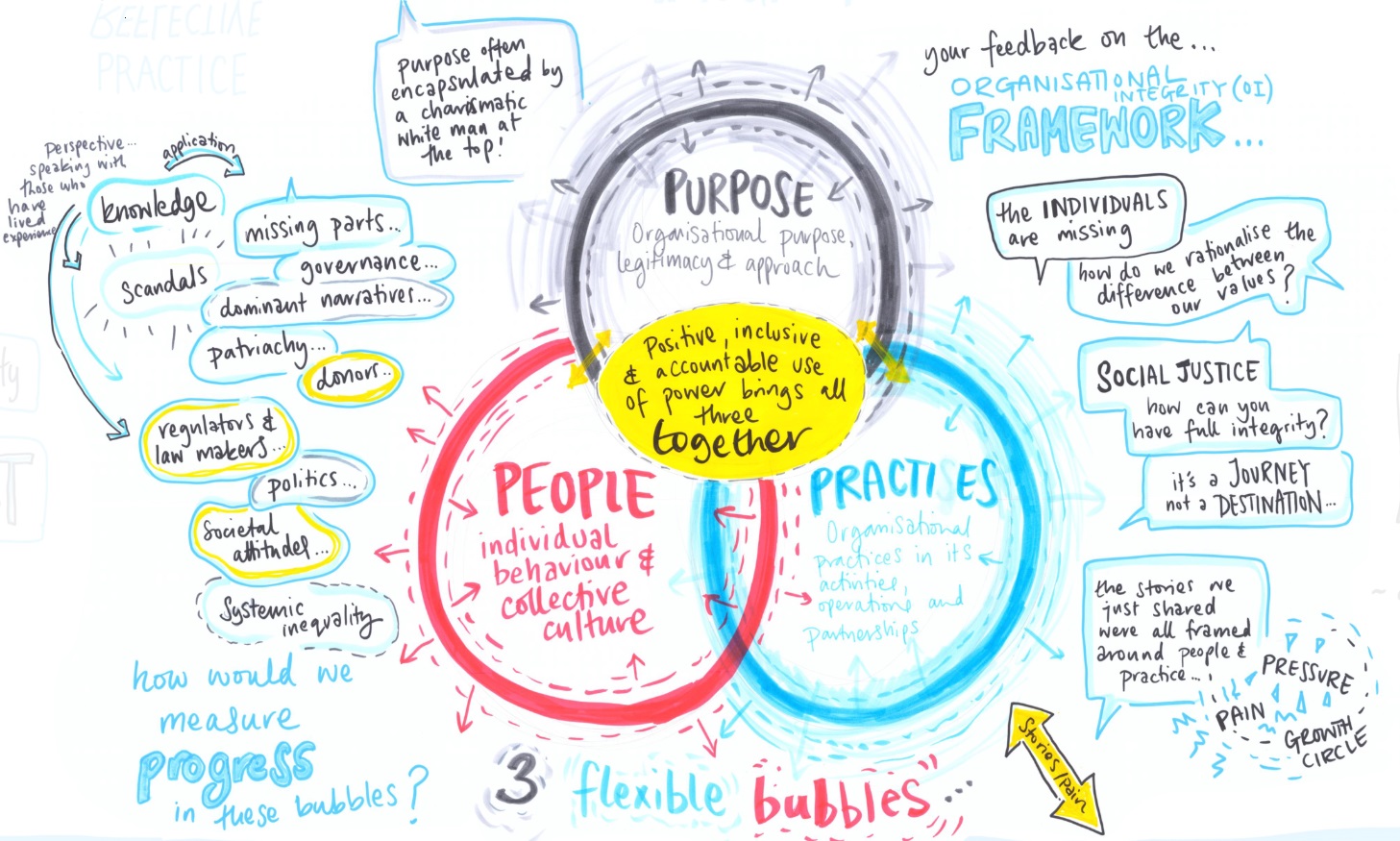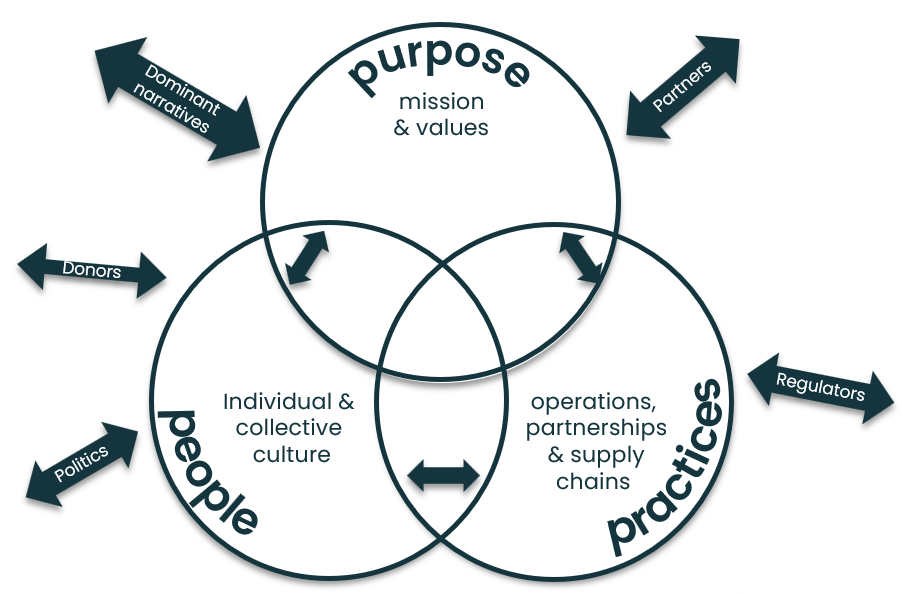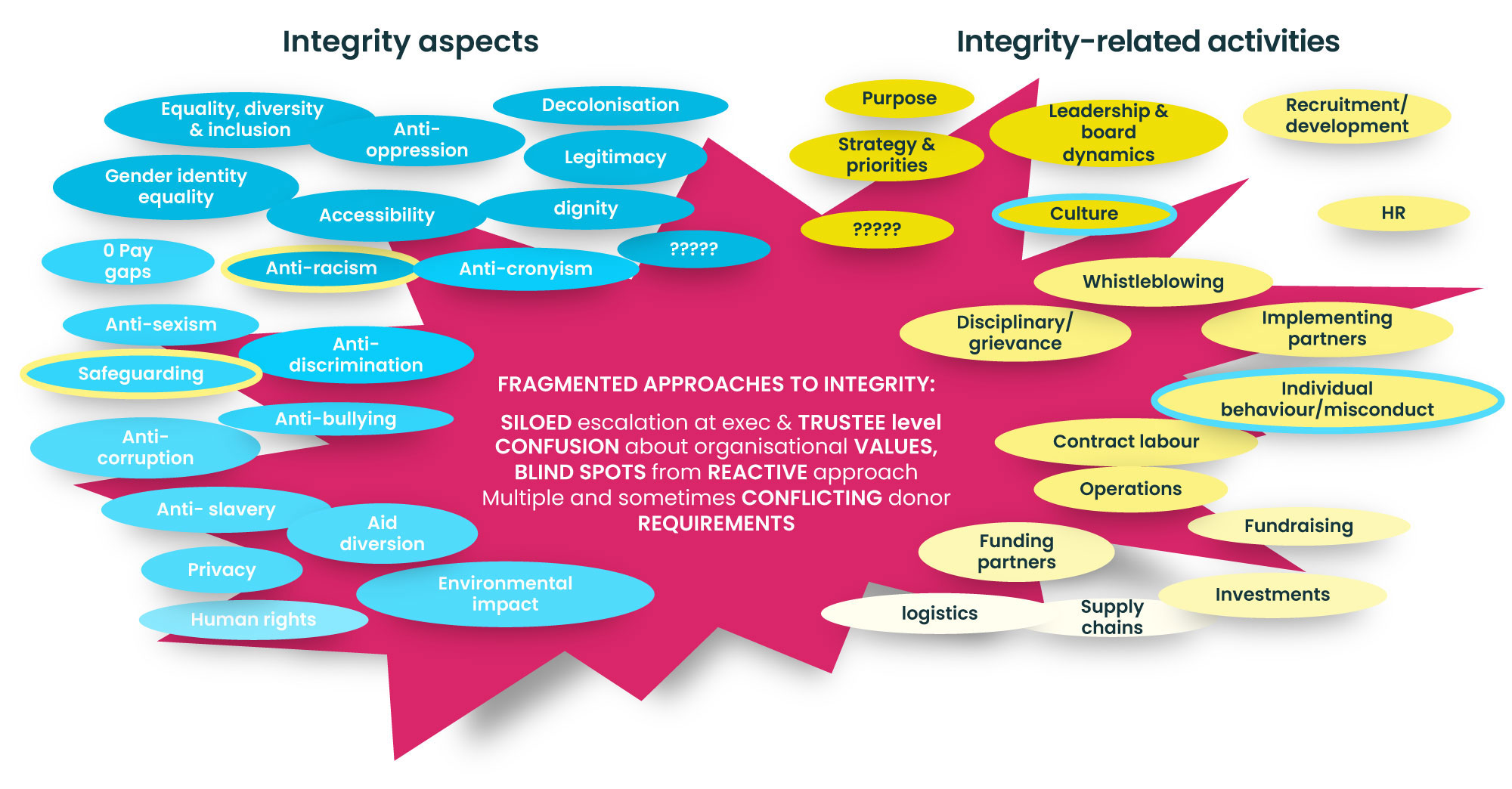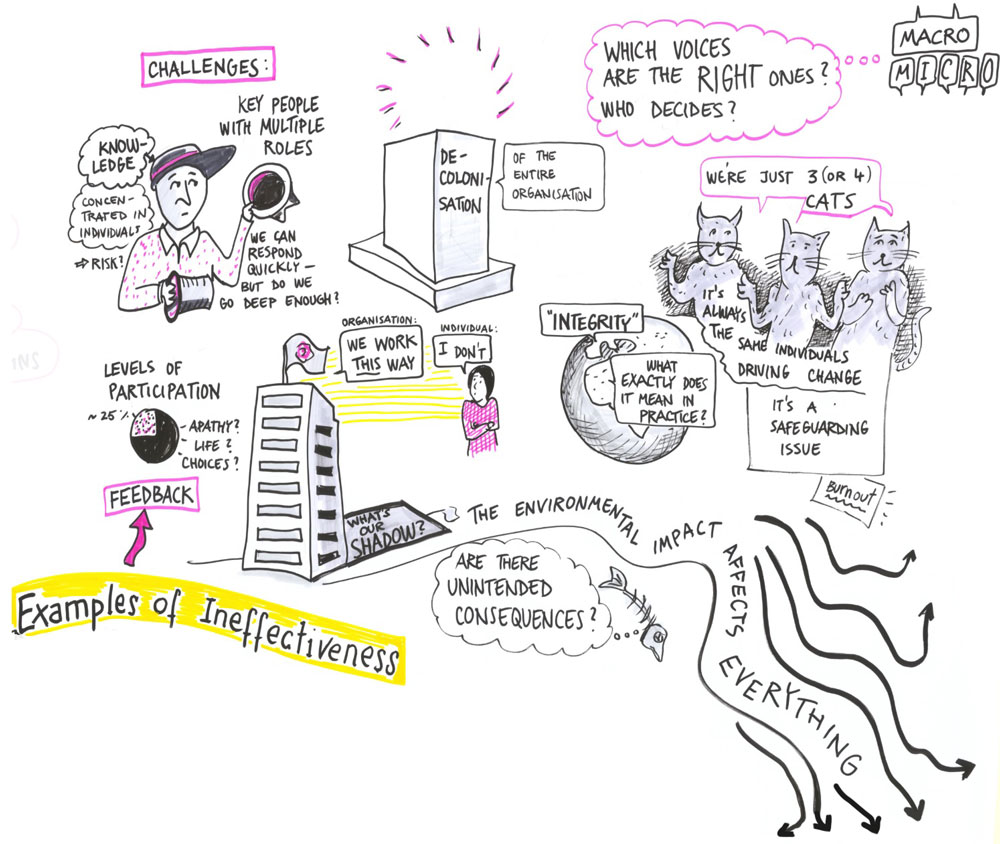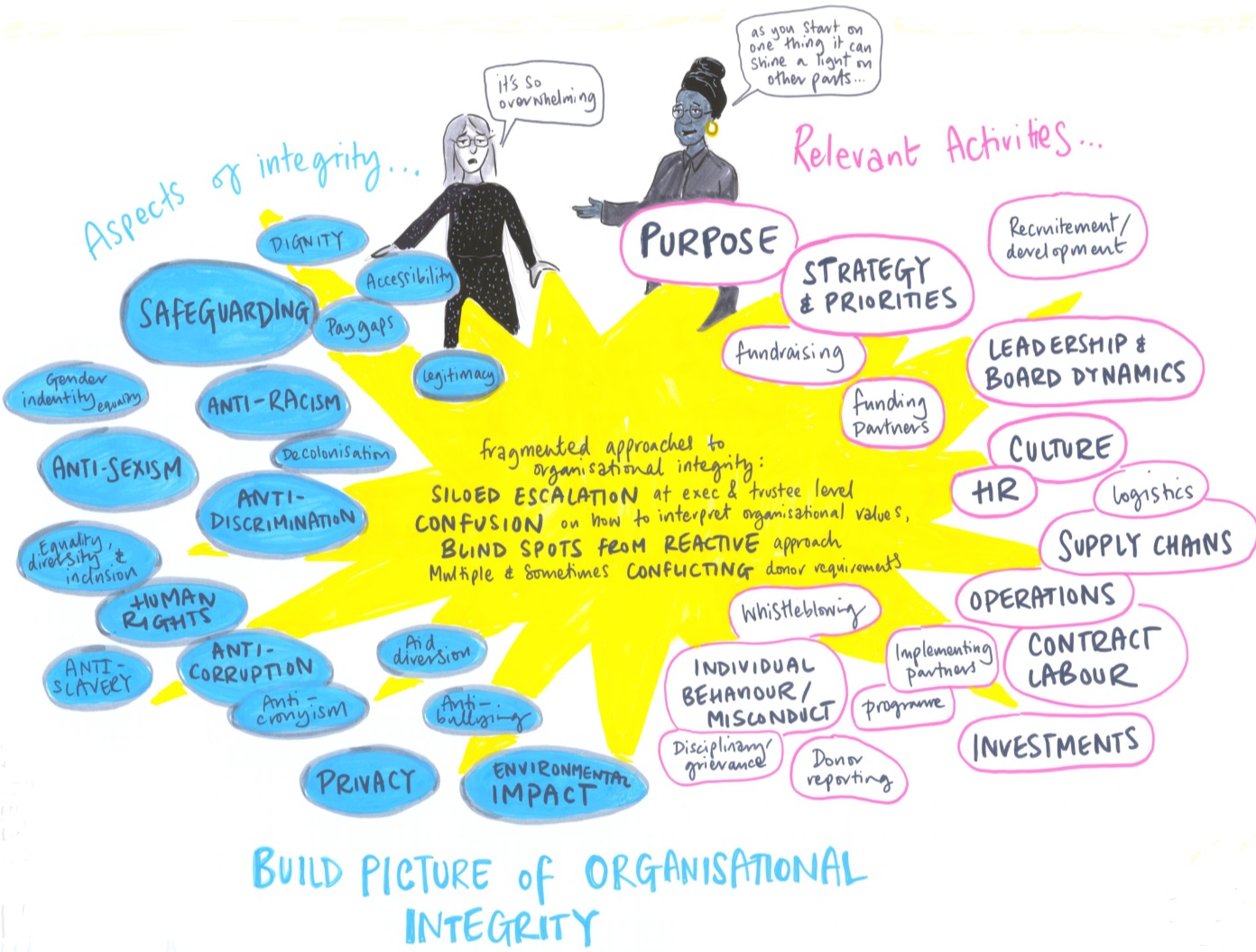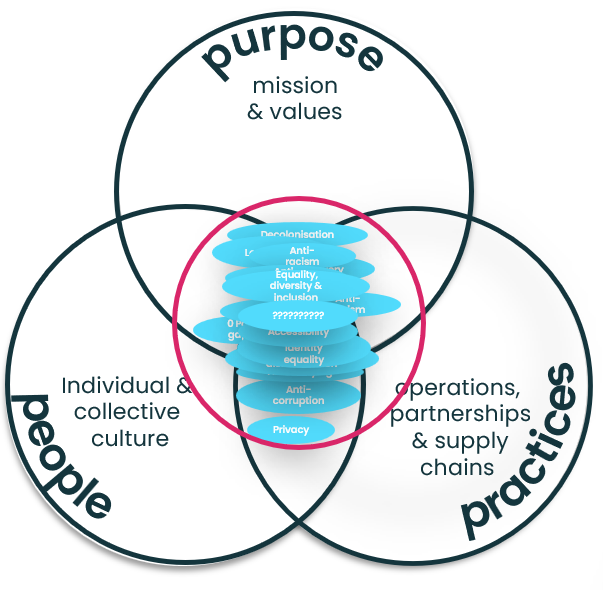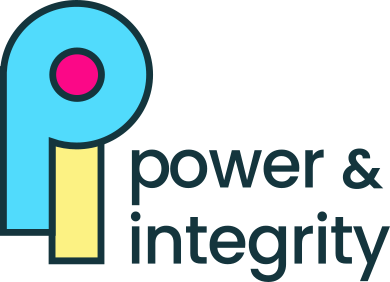Power lab learning
1Integrity
In Power Lab 1, we tested and refined our model for holistic organisational integrity, started to define a set of integrity principles and discussed the potential organisational benefits of working towards integrity.
Organisational integrity insights
Power lab 1
Aims and assumptions
We started with two assumptions:
- Integrity issues tend to be covered by different policies and managed by different teams. This issue-led approach is often reactive, tackling symptoms rather than the underlying causes.
- A holistic approach helps organisations identify underlying factors undermining integrity. They can then identify cross-cutting, foundational steps to manage integrity more coherently.
What is ‘organisational integrity’?
PI has adopted the term organisational integrity. For the lab, we proposed a working definition of this as ‘holistic and justice oriented’. The definition was purposely open to include emerging integrity areas.
Tools and Activities
Tools
The 3Ps Model
This is a simple model to look at where integrity issues and related activities sit within organisations. Starting with the premise that activities broadly fit within three spheres – purpose, people and practices – this helps participants step back, identify patterns and gain a more holistic overview of integrity.
Activities
Activities in this lab were participatory but quite structured and propositional in terms of content, methods and shared language. This created the groundwork and meanings we needed to work together. We started to look at what may be the scope of integrity, further developed the model for a holistic approach to integrity, and assessed to what extent organisations take a fragmented approach.
Organisational integrity
What we learned
1The 3Ps Model provides a high-level view of organisational integrity
After applying lived examples to the 3Ps Model, lab participants were in general agreement that:
- Integrity activities fit within an organisation’s purpose, people and practices
- The model is helpful in capturing a picture of what organisations do and how
- It is also useful for visualising how internal and external factors, such as donor requirements or dominant internal dynamics, can put pressure on the spheres.
2 Aligning an organisation’s 3Ps strengthens integrity
One sphere of the 3Ps Model can become too dominant, squeezing the other two. By overly prioritising delivery on its mission, an organisation can cause harm by under-investing in people and practices. Likewise, effective but highly elaborate processes can negatively impact service delivery or overstretch staff.
These pressure points are often noticeable within organisations. Even if not felt directly, they can be uncomfortable for staff. We concluded they are also key to informing an organisation’s learning journey about how to minimise pressures on the spheres and bring the 3Ps back into alignment.
Participants proposed a dynamic interpretation of the 3Ps model. Incorporating internal and external pressures makes it more useful for diagnosis – identifying pressure points, factors contributing to misalignment, and steps towards realigning the spheres.
3 We understand integrity as an emerging set of principles
Our original framing of organisational integrity was based on its scope: a range of issues and activities. We were defining it in terms of what it needs to prevent, rather than what it is.
By the end of the lab, we recognised that integrity is not fixed or static, nor a sum of its parts, or even a product of alignment. Instead, it is a set of emerging integrity principles, which if centred within the organisation’s purpose, people and practices can help bring them into alignment.
Emerging integrity principles
Integrity principles identified during the lab included:
- Holistic – coherent and centred within purpose, people and practices
- Dynamic and evolving – responding to new pressures, perspectives and information
- Justice oriented – equitable and intersectional
- Action oriented – providing accountability to commitments through action
4 An integrity-centred approach brings significant benefits
The fragmentation exercise highlighted many of the challenges organisations face when managing integrity.
We agreed that centring the integrity principles within the 3Ps model would enable more integrated, coherent understanding and action.
Potential benefits include:
- reducing duplication, inefficiency and confusion
- gaining an overview of potential risks – possible harms and their impacts
- identifying the foundational steps to put the organisation on the front foot for tackling emerging issues
- ultimately having greater impact, both internally and externally.
We are exploring the potential impacts of integrity further in our evolving theory of change, which we hope to share soon.
Post lab survey
Participant views
- The 3Ps Model is useful, but needs to evolve a bit more (rating is 3.6 out of 4)
- Participants felt their understanding of integrity was still quite theoretical. This became more tangible in Lab 2.
- We all felt we were had not reached a common definition of organisational integrity, but we were moving in a helpful direction.
- Participants fed back that we need to clarify what we mean by justice-oriented.
- While we better understood the causes of fragmented approaches to integrity, participants felt more work was needed to understand how to shift from fragmented to holistic in practice.
“I have referenced and referred to the 3Ps Model many times…which I think conveys its use and relevance. Thank you!”
Beyond the lab
Developing our learning
The PI team started to explore how an integrity-centred approach delivers an overall ‘more good’ rather than a ‘less bad’ approach. This raised an important question about the relationship between risk and integrity. We will explore this in PI’s next phase.
We are exploring the potential impacts of integrity further in our evolving theory of change, which we plan to share soon.
Activity
Integrity scoping
To develop a shared understanding of what integrity includes, we scoped integrity issues and relevant activities among the participant organisations.
Our goal was two-fold:
- investigate the scope of integrity
- illustrate the significant overlap between the organisations, regardless of size or mission.
The activity highlighted the sheer breadth of integrity-related areas of work, especially when combined with those of a further 45 organisations we had surveyed.
Activity
Introducing the 3Ps Model
This involved mapping integrity issues and activities from the scoping exercise on to our basic 3Ps Model: purpose, people and/or practice.
The activity demonstrated that although integrity-related activities are usually relevant to one, or perhaps two spheres, the issues themselves are more likely to relate to all three and tend to sit at the centre of the 3Ps model. This highlights the need for a holistic approach.
Activity
Exploring fragmentation
Participants worked with their colleagues to map out examples of integrity management within their own organisations. For each issue, they considered, inter alia:
- where it is managed
- what drives the need to address it
- other areas of organisation where it may be relevant
- board or executive oversight and potential blind spots
The activity demonstrated that organisations face a complex set of integrity issues across multiple activities, and the way they manage these is often siloed or conflated.
Find out more about the PI initiative
Check out our media channels
We’re starting to explain more about PI at events and via blogs and other media channels. See what’s available on our news page.
Stay updated
If you want to know how our work is progressing, why not join the PI mailing list? We’ll let you know about news, upcoming events and other important information.
Get in touch
Do you want to know more about participating in the PI initiative? Perhaps you have a media enquiry or just a general enquiry about our work? If so, let us know.


